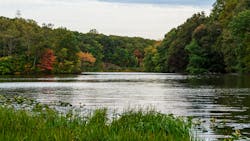The New Jersey Department of Environmental Protection (NJDEP) announced that it is awarding $9.95 million in grants to fund projects that will improve water quality and reduce the impacts of nonpoint source pollution from stormwater on publicly accessible lakes.
The department says that more than $8 million of the grants will fund projects on lakes in or next to overburdened communities in New Jersey, resulting in improved water quality and increased recreational opportunities for residents of these communities.
“These grants will help a diverse group of DEP partners implement projects that will reduce the harmful effects of stormwater, nonpoint source pollution and Harmful Algal Blooms (HABs) that will only worsen due to the impacts of climate change,” says Shawn M. LaTourette, NJDEP Commissioner. “On behalf of the Murphy Administration, we are excited to facilitate these projects in various overburdened communities to meet Department environmental justice and statewide water quality goals and objectives.”
The funding stems from a $10 million federal American Rescue Plan Act award to New Jersey that was appropriated by the state Legislature for the management and maintenance of lakes for recreation and conservation purposes. The grant funds can be used to improve lake water quality, control nutrient levels to prevent future harmful algal blooms, and to enhance, improve, or protect lake-associated conservation and recreation uses.
The award recipients and amounts are:
- Greenwood Lake Commission: $1 million
Working with Princeton Hydro, Montclair State University and Northern Lights, this project will conduct a comprehensive stormwater/nonpoint source management inventory and perform extensive water quality and HAB monitoring. The partners also aim to remove sediment, invasive plants, and debris via hydro-raking, provide nutrient inactivation in Belcher Creek with ferric sulfate and develop a long-term plan to improve Belcher Creek’s water quality and natural functions. - Lake Hopatcong Commission: $1 million
This project will focus on reducing phosphorus loading to minimize the magnitude, duration and occurrence of HABs. It involves working with four surrounding municipalities (Jefferson Township, Roxbury, Hopatcong and Mount Arlington) to install and remove biochar sleeves in two stormwater ponds and in a series of stormwater structures, manufactured treatment devices, and inlets into Lake Hopatcong. The project will also include the removal of sediment that has accumulated immediately in front of or adjacent to stormwater pipes or outfalls that discharge directly into the lake. - Deal Lake Commission: $890,400
Green infrastructure Best Management Practices and other DEP-approved stormwater management devices will be used to reduce nonpoint source pollutant loading and improve lake water quality. A preliminarily designed stormwater quality improvement plan developed with Ocean Township, Monmouth County and Seaview Square Mall also will be implemented. - Spring Lake: $850,000
Funds will be used to collect pre-project site-specific survey/topographic data, engineering sizing, hydrologic modeling and baseline ecological data. The borough also would perform required lake dredging and safe disposal of dredged material. - New Jersey Water Supply Authority (NJWSA): $825,500
For NJWSA, three projects are planned: - The first, for $90,000, will lead to the installation of Aquatic Invasive Species (AIS) removal boat-cleaning stations at the Spruce Run Reservoir (Hunterdon County) and Manasquan Reservoir (Monmouth County) boat launches. The stations will be matched with Boat Steward Inspection programs sponsored by the NJWSA, which inspects launching and retrieved boats for attached AIS, educates boaters on the dangers of such species and strives to improve disinfection practices.
- The second project, for $173,000, will improve water quality in the Spruce Run Reservoir and Mulhockaway Creek watersheds. The NJWSA will incentivize and implement agricultural conservation practices to reduce pollutant loads in the watershed and to the reservoir. It will also reduce the instances of HABs that are affecting the reservoir’s water supply and recreational use.
- A third project for $562,500 proposes three years of sampling and analysis to characterize physical, chemical and biological water quality parameters at Spruce Run Reservoir.
- New Jersey Institute of Technology: $788,235
The project will develop lake watershed-based restoration and protection plans by implementing green infrastructure projects at two watersheds using Green Engineered Mulch. An educational component will focus on teaching local high school students about green infrastructure designs and benefits. - Morris County Park Commission: $722,037.75
Green stormwater infrastructure such as permeable pavement systems will be used to intercept on-site runoff, allowing for structured parking areas while reducing stormwater nutrient loads entering Lake Hopatcong. - Pinelands Preservation Alliance: $581,500
The project calls for installing 80 green stormwater infrastructure projects surrounding 10 public lakes, five in the Highlands and five in the Pinelands. Converting 130,000 square feet of drainage area to green stormwater infrastructure will improve the functionality of the lakes, which suffer from pollutant overloading and limit recreational uses. - Lake Musconetcong Regional Planning Board: $572,000
The project will fund the continued operation of a mechanical weed harvester on the lake. Since 2010, the program has removed more than 21.9 million pounds of weeds, according to the applicant, which has resulted in the removal of almost 4,000 pounds of phosphorus from the waterbody. - Avon-by-the-Sea: $490,768
This project will implement the second phase of the Sylvan Lake Living Shoreline Project, a natural solution-based project designed to mitigate nonpoint source pollution impacting the waterway, a coastal lake on the border of Avon and Bradley Beach. - Swartswood Lakes and Watershed Association: $361,377
Weed hydro-raking and harvesting will be conducted to reduce nutrients in the lake, improve lake water circulation, reduce lake water temperatures in weeded areas, enhance recreational value and improve fisheries. - Lawrence Township: $316,800
A multilayer approach will be used to improve Colonial Lake water quality through hydro-raking, removing impervious surfaces (an asphalt parking lot) and installing a living shoreline. - Hillsborough: $246,000
Reducing pollutant loads to Fox Chase Pond will stabilize the pond's eroding shoreline, restore a vegetative buffer and educate the public about the importance of stormwater management and green infrastructure. - South Jersey Resource Conservation and Development Council: $243,122
This project will continue implementation of a Watershed Protection and Restoration Plan for the Manalapan Brook Watershed. - Perth Amboy: $200,000
Activities for this project primarily include the removal of the invasive plant, Phragmites, from areas surrounding Willow Pond as well as the implementation of measures to prevent regrowth. The project also includes algae control, water quality monitoring, replacement of goose deterrent strobe lights, removal of woody debris, installation of three new aerators, shoreline planting and public outreach activities. - Florham Park: $176,900
This project involves designing, installing and monitoring a system to reduce phosphorus concentrations, decrease HABs and shift to a healthier plankton assemblage that serves as the base of the aquatic food web. - Camden County Soil Conservation District: $153,720
Project partners, led by the Camden County Soil Conservation District, propose developing an EPA Watershed Implementation Plan for the Cooper River Lake Watershed that will also address climate change impacts. - Moorestown Township: $113,500
An in-lake vegetation removal management project will be implemented in Strawbridge Lake and Pennsauken Creek (North Branch) to remove up to 15 acres of the overabundant noxious species Spatterdock from the lake. - South Jersey Resource Conservation and Development Council: $102,426
The grant will follow an EPA Watershed Implementation Plan for Smithville Lake Watershed to address water quality impairments. - Bay Head: $99,900
The goal of this project is biochar installation and evaluation of its potential for nitrogen and phosphorus removal in Twilight Lake. The project aims to document the amount of phosphorus and nitrogen removed from biochar, a charcoal-like material that can filter out water impurities, during six-month periods. - Point Pleasant Beach: $99,300
The borough will develop a Lake/Watershed Plan that integrates standard U.S. Environmental Protection Agency (EPA) criteria to provide a roadmap to water quality improvement. - Burlington: $95,000
The community will create a Lake Characterization Plan and a future Lake Watershed Protection Plan, both of which will identify water quality preservation measures to support stormwater detention/filtration and expanded recreational activities. - Mount Arlington: $36,100
Funds will be used to construct five rain gardens across the borough in critical runoff areas and measure the impact of the gardens and mitigation of stormwater runoff. Residents will be able to use a how-to guide on the borough’s website to learn how to plant their own rain garden and track the borough’s progress via social media.






